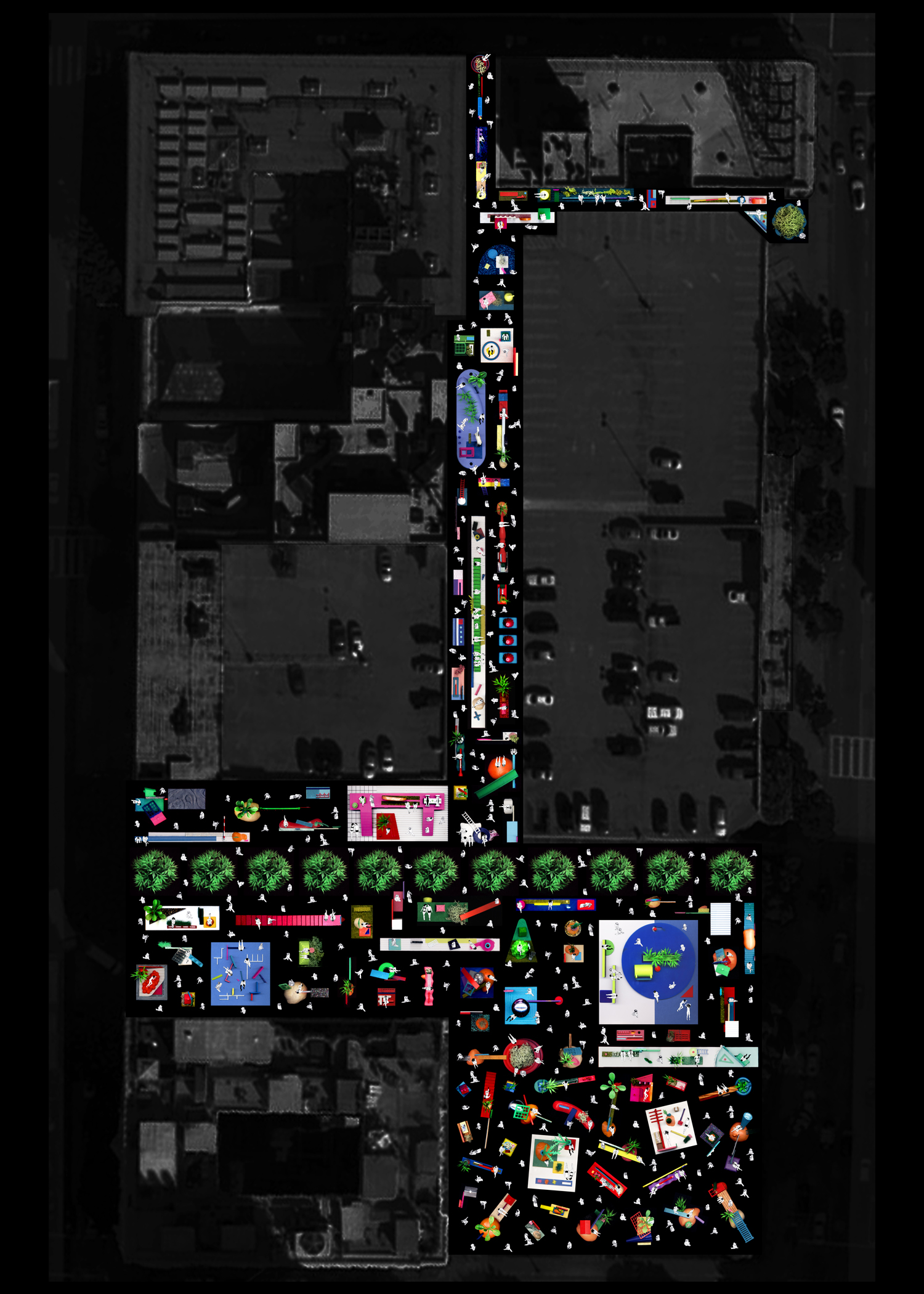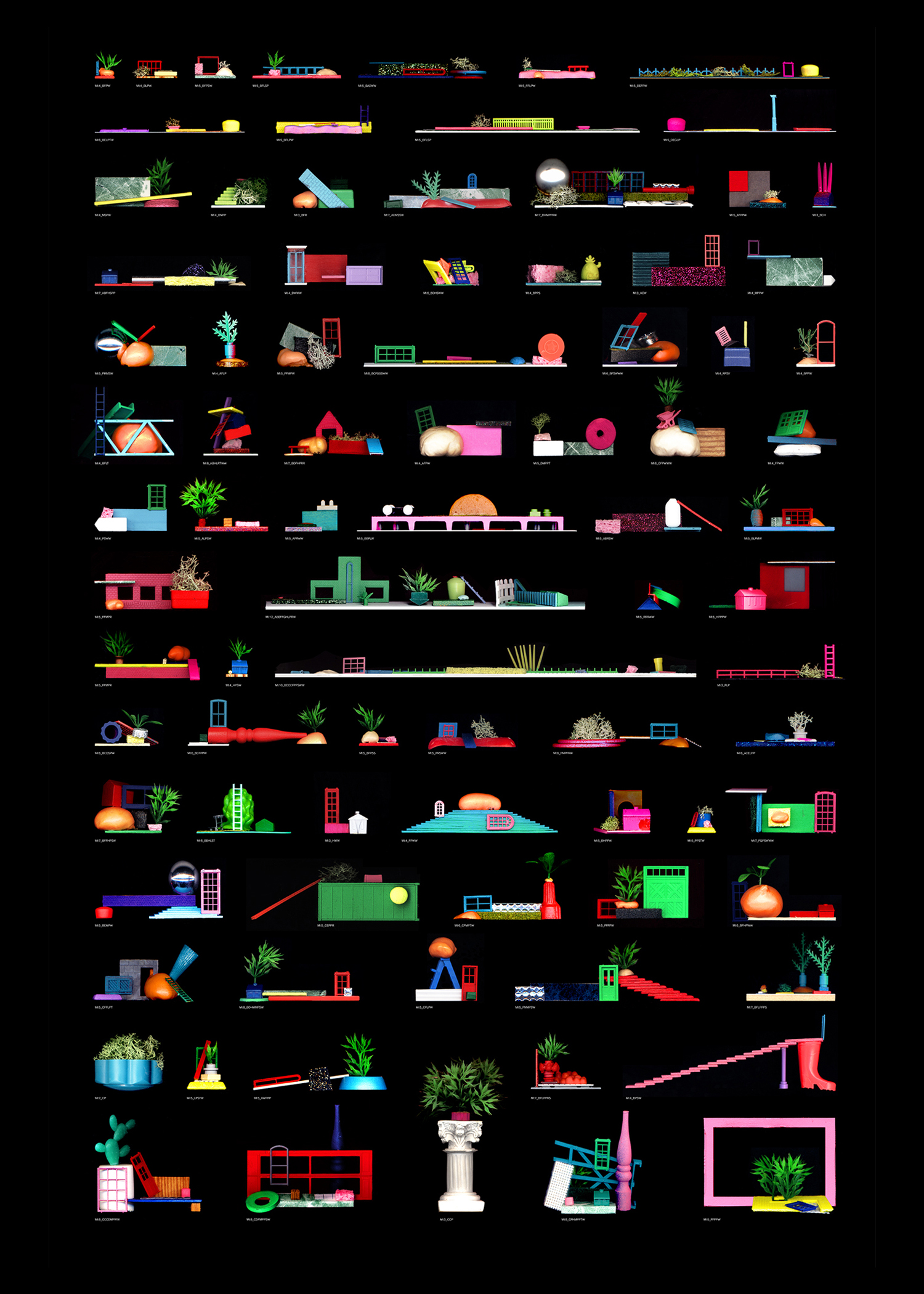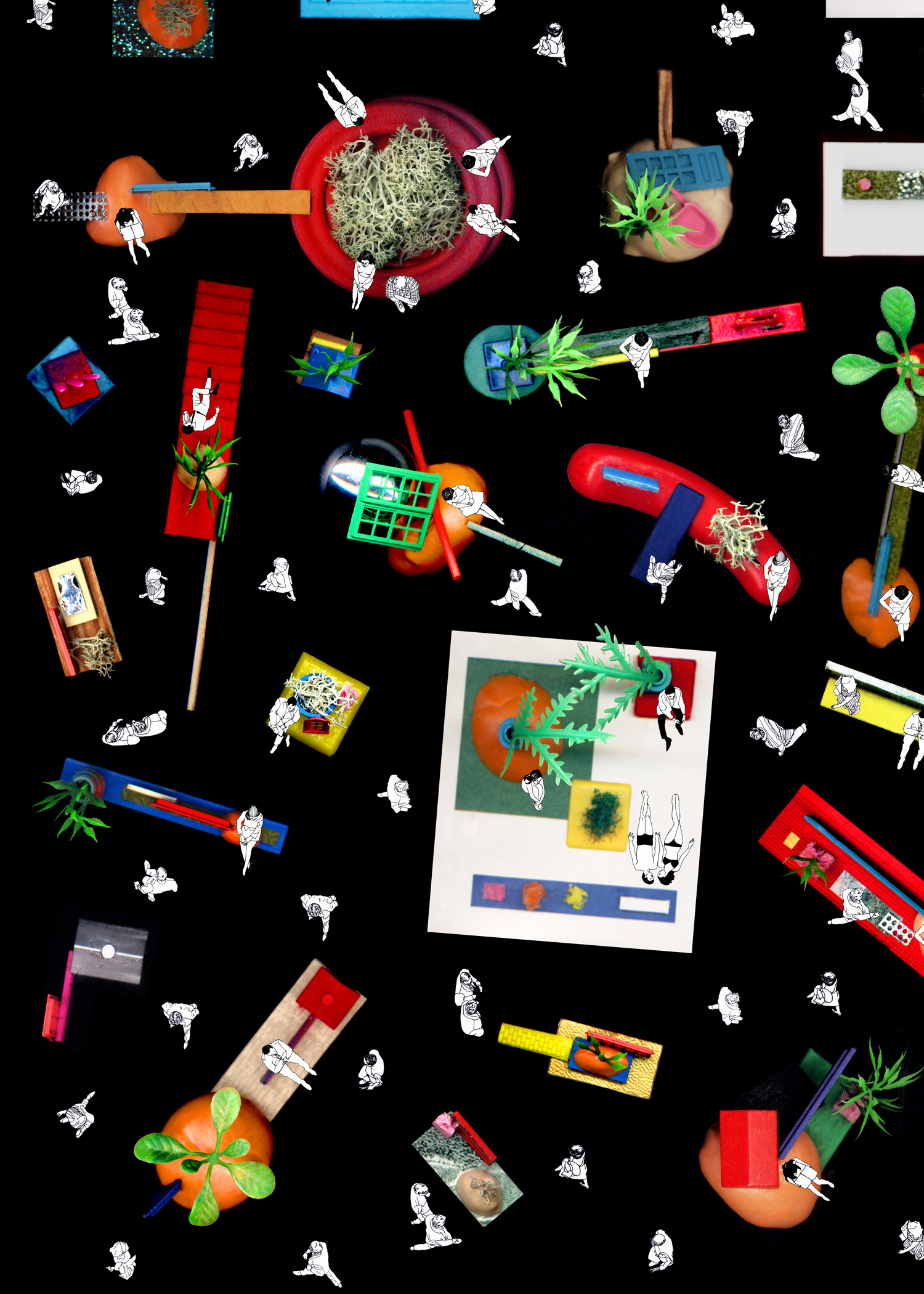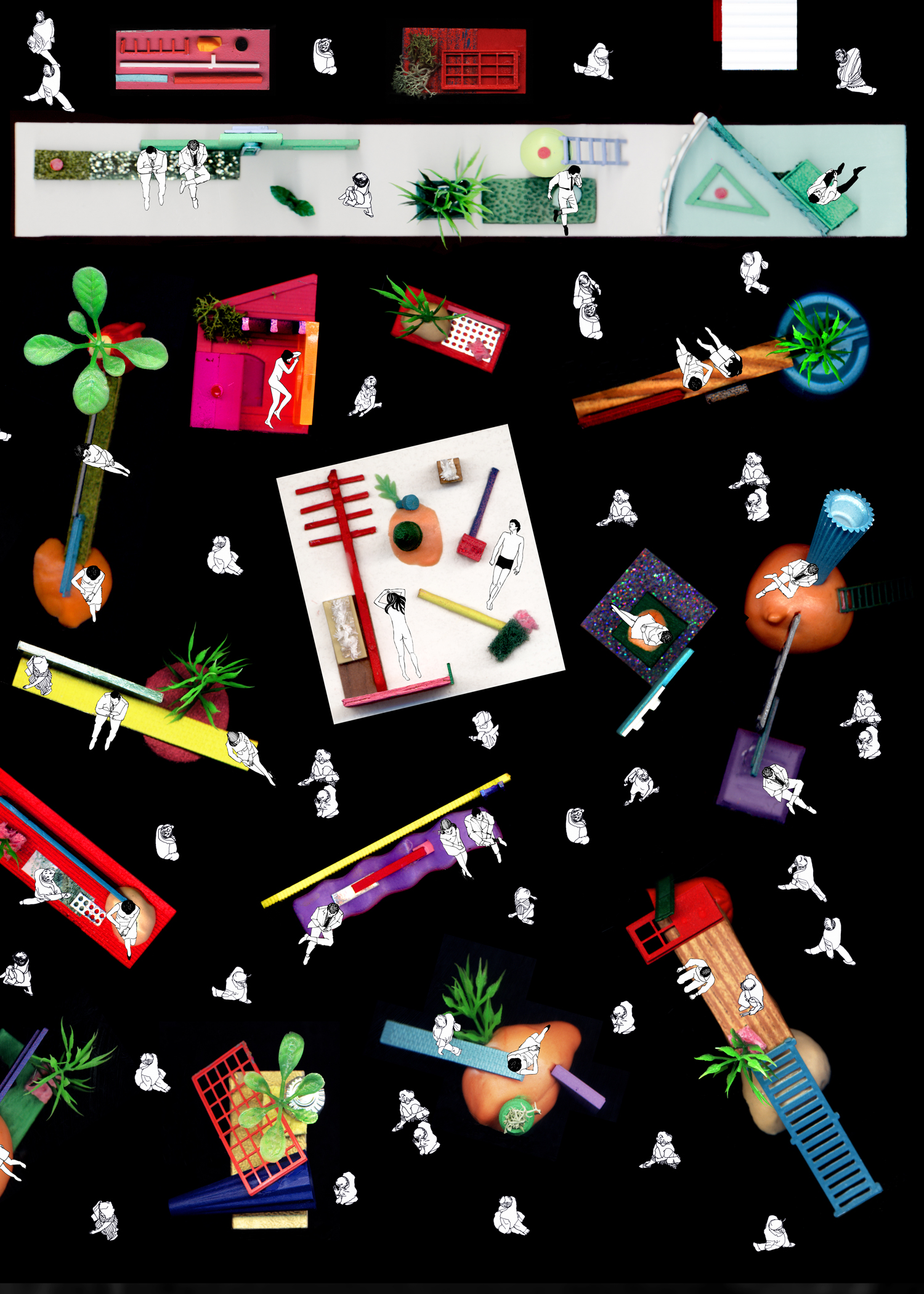
LOS ANGELES ALLEYS
Proposal for Downtown Alleys, Los Angeles, California, 2017
Exhibited at the Architecture and Design Museum as part of City LAB’s LA Times 10, 2017
Team: Andrew Kovacs, Yessenia Juarez, Erin Wright, Israel Ceja, Peter Boldt, Jena Meeks, Naomi Steinhagen
Project Description:
Downtown Los Angeles is currently experiencing a building boom. While many parking lots have instantly turned into construction sites the emphasis on a broader city-wide pedestrian network has failed to keep up. At the same time, an existing informal network of alleys and surface parking lots provide pedestrian shortcuts for daily downtown life. Furthermore, some of these thoroughfares have become formalized shortcuts such as the Historic St. Vincent’s Court, Grand Central Market, The Spring Arcade Building, and Biddy Mason Memorial Park. This proposal considers the existing alleys and parking lots as territory for the public realm. Much like the High Line in New York City, the alleys and surface parking lots of Downtown Los Angeles are an existing infrastructure that form a fertile territory for a Los Angeles street level High Line, or Horizontal Line made up of public avenues and squares. This proposal aims to tap into the existing infrastructure of alleys, as well as surface parking lots and propose a new leisure network of public avenues throughout downtown.
The ambition of this project is an architectural and urban proposal for the alleyways and surface parking lots in downtown Los Angeles that are populated and activated with micro-architectural interventions. Through quantity these micro-architectural interventions generate a new type of collective and leisure space that is pedestrian focused. In other words, the idea is a new type of public park, free and open to all, in the network of alleyways and surface parking lots in Downtown Los Angeles.
The proposal imagines the grouping and quantity of micro-architectural interventions in an urban context as forming a new urban network, devoted to pedestrians and leisure. This expanding horizontal conglomerate of micro architectural interventions is overlaid on an existing network of city streets and sidewalks, positing a new city network at the scale of a pedestrian against the generally multi-level and stacked buildings of Downtown Los Angeles.
The most important scale for this project is that of the downtown city block. Through the size of micro-architectural interventions their placement, organization, arrangement, and function can alter and adjust block to block. While the site for this particular study and proposal is focused on Downtown Los Angeles, the idea of a multiple micro architectural interventions grouped in a dense quantity to allow for a new type of collective space can be transferred to other leftover, residual, underused, and undervalued spaces in other type of urban environments throughout Los Angeles. The ability for the proposal to adapt and proliferate to other locations is to be understood through the micro/pedestrian scale. At this particular moment in time, the alleyways and surface parking lots of Downtown Los Angeles are a fertile testing ground due to rapid development.
As demonstrated in the proposed plan, the concept is to occupy and fill both alleyways and surface parking lots on a Downtown Los Angeles city block with micro architectural interventions. These micro architectural interventions are a new densely packed landscape devoted to activities of leisure. Activities of leisure to be proposed are botanical gardens, swimming pools, bike paths, sport courts, dog parks, shaded resting areas (for sitting or sleeping), viewing platforms, follies, pavilions, etc. Forms of leisure to be proposed are ziggurats, strips, mounds, colonnades, hypostyle halls, stairways, fields, etc.
As much of the new construction in the current building boom of Downtown Los Angeles nears completion one can start to see the rooftops of these new structures take shape on satellite views. These rooftops are devoted to activities of leisure, yet they are privatized. The idea of the city as a place of collective living is replaced by isolated and detached spaces. This proposal aims to generate leisure space for all. Rather than elevating activities of pleasure high in the sky, these activities are proposed on the street, for the public to enjoy.
An important disciplinary subplot of this proposal is to position the project in parallel (not against or for) the American urban renewal project of the pedestrian mall. The pedestrian mall aimed to close streets and limit vehicular traffic in the name of commercialism and consumption. Sometimes some of those projects succeeded and sometimes they failed. With that said, this is not a proposal for a pedestrian mall. The goal will is for an alternative to the pedestrian mall - a new type of urban park for the pedestrian and devoted to collectively and leisure.
The ambition of this project is an architectural and urban proposal for the alleyways and surface parking lots in downtown Los Angeles that are populated and activated with micro-architectural interventions. Through quantity these micro-architectural interventions generate a new type of collective and leisure space that is pedestrian focused. In other words, the idea is a new type of public park, free and open to all, in the network of alleyways and surface parking lots in Downtown Los Angeles.
The proposal imagines the grouping and quantity of micro-architectural interventions in an urban context as forming a new urban network, devoted to pedestrians and leisure. This expanding horizontal conglomerate of micro architectural interventions is overlaid on an existing network of city streets and sidewalks, positing a new city network at the scale of a pedestrian against the generally multi-level and stacked buildings of Downtown Los Angeles.
The most important scale for this project is that of the downtown city block. Through the size of micro-architectural interventions their placement, organization, arrangement, and function can alter and adjust block to block. While the site for this particular study and proposal is focused on Downtown Los Angeles, the idea of a multiple micro architectural interventions grouped in a dense quantity to allow for a new type of collective space can be transferred to other leftover, residual, underused, and undervalued spaces in other type of urban environments throughout Los Angeles. The ability for the proposal to adapt and proliferate to other locations is to be understood through the micro/pedestrian scale. At this particular moment in time, the alleyways and surface parking lots of Downtown Los Angeles are a fertile testing ground due to rapid development.
As demonstrated in the proposed plan, the concept is to occupy and fill both alleyways and surface parking lots on a Downtown Los Angeles city block with micro architectural interventions. These micro architectural interventions are a new densely packed landscape devoted to activities of leisure. Activities of leisure to be proposed are botanical gardens, swimming pools, bike paths, sport courts, dog parks, shaded resting areas (for sitting or sleeping), viewing platforms, follies, pavilions, etc. Forms of leisure to be proposed are ziggurats, strips, mounds, colonnades, hypostyle halls, stairways, fields, etc.
As much of the new construction in the current building boom of Downtown Los Angeles nears completion one can start to see the rooftops of these new structures take shape on satellite views. These rooftops are devoted to activities of leisure, yet they are privatized. The idea of the city as a place of collective living is replaced by isolated and detached spaces. This proposal aims to generate leisure space for all. Rather than elevating activities of pleasure high in the sky, these activities are proposed on the street, for the public to enjoy.
An important disciplinary subplot of this proposal is to position the project in parallel (not against or for) the American urban renewal project of the pedestrian mall. The pedestrian mall aimed to close streets and limit vehicular traffic in the name of commercialism and consumption. Sometimes some of those projects succeeded and sometimes they failed. With that said, this is not a proposal for a pedestrian mall. The goal will is for an alternative to the pedestrian mall - a new type of urban park for the pedestrian and devoted to collectively and leisure.






